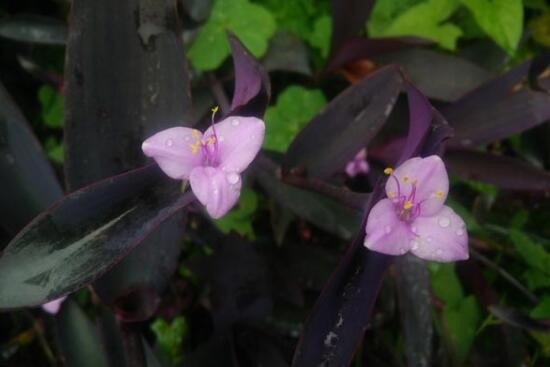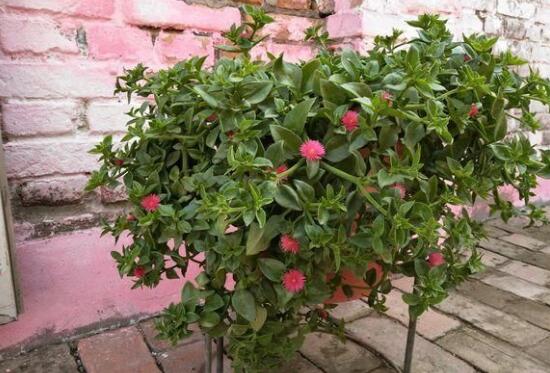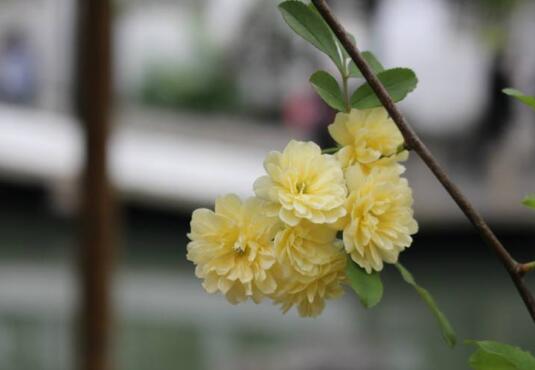The efficacy and function of purple duck foot grass, bright ornamental branches and leaves / medicinal can cure all kinds of diseases.
Purple duckweed, also known as purple bamboo plum, is an overall purplish red, looks very beautiful plant. In life, because the purple metatarsus is good-looking, it is kept at home by many people. However, if you only think that purple metatarsus is good-looking, it is a big mistake, because the efficacy and effect of purple metatarsus is very strong, especially in medicine, it can cure all kinds of diseases, let's go and have a look.
What is the function of purple duck metatarsus, ornamental / medicinal

Each plant raised at home will play a different role, such as the wealth tree, the happiness tree, the money tree and so on, which can not only be watched, but also have a beautiful meaning, so what is the use of the same beautiful purple duck metatarsal grass? In this regard, after the editor's inquiry, purple duck metatarsus is not only good-looking, but also has good economic value, but also has a very good use in medicine.
Second, the efficacy and function of purple duck foot grass.
1. Ornamental value
To talk about the efficacy and function of purple duckweed, the first thing that comes to mind is its ornamental value. As shown in the picture above, the purple duckweed flower is shaped like a plum blossom and looks particularly charming against the purple-red leaves. Put the purple metatarsus on the sunny balcony, it looks particularly beautiful in the sunlight.
2. Landscape value
In addition to being placed indoors as a potted plant, purple duckweed is also a typical constant-color leaf plant in scenic spots. Matching purple metatarsus with other flowers and plants in harmony with the surrounding environment can give full play to its unique color beauty and create a beautiful landscape.
3. Purify the air
As a green plant, purple duckweed also has a good ability to purify the air. In indoor breeding, purple metatarsus can absorb carbon dioxide, carbon monoxide and other gases, and release the oxygen needed by the human body. When the indoor air is fresh and people live in it, their health is guaranteed.
4. Economic value
It is understood that natural pigment can also be extracted from purple duckweed. It has good water solubility, bright and natural color, stable nature and certain health care effect. It can be used in daily chemical products such as beverage, fruit wine and cosmetics. So the economic value is also one of the functions and functions of purple duck metatarsal grass. If you raise it, you can sell it for money.
5. Medicinal value
In addition to the above points, the efficacy of purple duckweed is also reflected in medicine. It is understood that purple metatarsus can be used as medicine, which has the effects of cooling blood, relieving depression, moistening the lungs and diuresis, and has a good effect on the treatment of injury, hematemesis and congestion.
Generally speaking, purple duck metatarsus is very beautiful, whether it is planted indoors or outdoors, it has a good effect, and it has a lot of benefits to people. So interested friends, you might as well raise a pot at home, and after the purple duckweed blossoms, you will enjoy its beauty. With regard to the efficacy and function of purple duck metatarsus, the editor has introduced this, hoping to bring help to everyone.
The efficacy and function of Diaozhumei: medicinal efficacy
Phyllostachys angustifolia is a perennial herb of the family Caryophyllaceae, also known as Phyllostachys pubescens, Phyllostachys pubescens, purple back duckweed, with the functions of heat-clearing and detoxification, cooling blood and hemostasis, diuresis, mainly clearing heat and dampness, cooling blood and detoxification, main non-swollen, unfavorable urination, gonorrhea, dysentery, lower band, hemoptysis, red swelling and pain, sore throat, sore carbuncle, burn and scald, venomous snake bite and so on.
Ornamental function
Hanging bamboo plum grows rapidly, the branches and leaves are creeping and hanging, the leaves are purple, green and silver alternately, dazzling, planted with potted plants, placed on several high shelves, the top of the cabinet is allowed to droop naturally, forming a green curtain, the appreciation effect is very good, do not have a mood, home, courtyard and other places are often used for overall layout.
Air purification effect
The plants more or less have the function of fresh air, and the hanging bamboo plum is no exception, and the growth of the hanging bamboo plum is exuberant, so it is a kind of herbaceous foliage plant which is very suitable for little investment, and the land is covered with greening quickly and well. The air is also relatively fresh in large areas covered with hanging bamboo plums.
Above we introduced the efficacy of Diaozhumei, the ornamental of Diaozhumei is relatively high, many people know that its stems and leaves are highly ornamental, in fact, its flowering is also beautiful, do you know how to make it bloom more? Let's take a look.
The culture method of purple back evergreen has very good medicinal value.
Purple-backed evergreen is a common indoor foliage plant, which is suitable for family balconies, rooms, reception rooms and other public places. In addition to having a very good ornamental value, purple-backed evergreen has a very good medicinal value. Let's learn about the breeding method of purple-backed evergreen with the editor of wed114.
Introduction of purple back evergreen
Purple evergreen, also known as clam flower, blood sorrow, purple orchid, red-faced general, etc., belong to the evergreen perennial herb of the family Caryophyllaceae, like warm and humid climate, and the requirement for tuhao is to be fertile and keep water power. When planting clam flowers, watering should not be too frequent, otherwise it is easy to cause rotten roots. In ramet culture of clam flowers, it is generally chosen to analyze when turning the pot in spring, and it will take about two weeks to take root, while if you choose to sow seeds, you will generally choose to plant in April and transplant in time after emergence, and you can grow into plump plants in autumn.
Purple back evergreen medicinal efficacy:
The purple back is sweet and light, and it has a good effect of clearing heat and resolving phlegm, cooling blood and relieving dysentery. It is generally used for lung dryness cough, hematochezia and lymph node tuberculosis. The use of mussel flowers is generally about two pairs of fresh leaves, or between 20 and 30 dried flowers. If it is for the treatment of hemoptysis and hematochezia, it is to choose dried flowers and pig lean meat to be fried in clear water, while for the treatment of lung dryness cough. Is the dried clam flower and jujube fried with water, the effect is very good. In addition, clam flowers can also be applied externally, mashed with fresh leaves and applied to the affected area for the treatment of vulva and lip sores.
But it should be noted that the purple back evergreen rhizome part is toxic, accidentally eating the rhizome will appear nausea, abdominal pain, limb chills and even coma symptoms. In general, mucus sticking to the hands or skin can cause allergic reactions, plaques or itchy sensations.
Purple back evergreen culture method:
The main results are as follows: (1) temperature: like warm climate, it can grow all year round under the temperature above 15 °C, and the most suitable temperature for growth is 15 °C and 25 °C. It is not cold-resistant, stops growing below 10 °C, enters dormancy at 5 °C, and the overwintering temperature is best maintained above 5 °C.
(2) Illumination: like semi-overcast and sufficient scattered light. Avoid scorching sun exposure, May to September should be shaded, cover about 50% of the light. When the light is too strong, the leaves will curl, turn yellow and lose luster, and the plants will grow short. Should not be too overcast, the time of placing indoor shade should not be long, otherwise the plant will become slender, the internodes elongate, the leaves become thinner, the color darkens, thus losing the ornamental value. It should be laid out in the dark for 2 to 3 weeks and then moved to a place where scattered light is sufficient for recuperation.
(3) watering: because the stems and leaves are slightly fleshy, the plant contains more water, so it has a certain ability to resist drought. Even if it is not watered for several days, it will not dry to death, but it grows best when the soil is moist. Watering during the growing period should master the original principle of "no dry, no watering, watering thoroughly" and keep the basin soil moist. But avoid wet waterlogging, too wet can easily cause rotting roots. In winter, watering is reduced to keep the basin soil relatively dry. Cold and humid environment can easily lead to plant freezing injury, and water collapse will appear at the tip of the leaf.
(4) Environmental humidity: like humid environment. If the growing season is sunny and dry, water should often be sprayed to the branches and leaves to improve the relative humidity of the air. Only under the humid conditions can the plants grow luxuriantly and the branches and leaves are delicate. When the weather is hot and dry, the leaf tip will be scorched.
(5) fertilization: the fertilizer combined with nitrogen, phosphorus and potassium was applied every 10 to 15 days to make the branches and leaves grow vigorously and the leaves more colorful. Stop applying nitrogen fertilizer in September and apply only nitrogen fertilizer in order to improve the cold resistance of the plant. Stop fertilizing in winter.
(6) pruning: young plants should be coring to promote branching. In order to make the plant shape plump and beautiful, the long branches should be pruned in time. For the old plants cultivated for more than 3 years, because the basal leaves will wither and yellow, which will make the plant loose, the growth potential will become worse, and affect the plant shape, we should carry out strong cutting and renewal combined with turning the basin in spring to make it sprout new branches and form an ideal plant shape.
(7) turn the basin: turn the basin once every 2 years. Like fertile and well-drained sandy loam, not suitable for heavy soil, with too heavy soil planting, easy to make the root rot. The matrix can be prepared with rotten leaf soil, peat soil, garden soil, coarse sand and other materials.
(8) Prevention and control of diseases and insect pests: crustacean pests often occur when the overwintering temperature exceeds 8 degrees. There is also the harm of leaf blight.
- Prev

How to raise peony orchid in winter, the difference between peony orchid and Tianqi / 4 points is easy to distinguish.
Because the peony hanging orchid is effective and good-looking, it is kept indoors by many people. However, the peony orchid is afraid of the cold, so winter maintenance must pay attention to, how to raise the peony orchid in winter? I have already mentioned the difference between andrographis paniculata and peony orchid, and recently, some people have confused the peony orchid with Tian Qi.
- Next

How to apply fertilizer to woody flowers, how to water woody flowers/thin fertilizer frequently applied/avoid water accumulation
Aucklandia is a common flower plant in people's life. It can be seen in many parts of our country. However, if you want to raise it well, you need to pay attention to many places, among which fertilization and watering are the most important. How to apply fertilizer to flowers? How to water flowers?
Related
- Fuxing push coffee new agricultural production and marketing class: lack of small-scale processing plants
- Jujube rice field leisure farm deep ploughing Yilan for five years to create a space for organic food and play
- Nongyu Farm-A trial of organic papaya for brave women with advanced technology
- Four points for attention in the prevention and control of diseases and insect pests of edible fungi
- How to add nutrient solution to Edible Fungi
- Is there any good way to control edible fungus mites?
- Open Inoculation Technology of Edible Fungi
- Is there any clever way to use fertilizer for edible fungus in winter?
- What agents are used to kill the pathogens of edible fungi in the mushroom shed?
- Rapid drying of Edible Fungi

